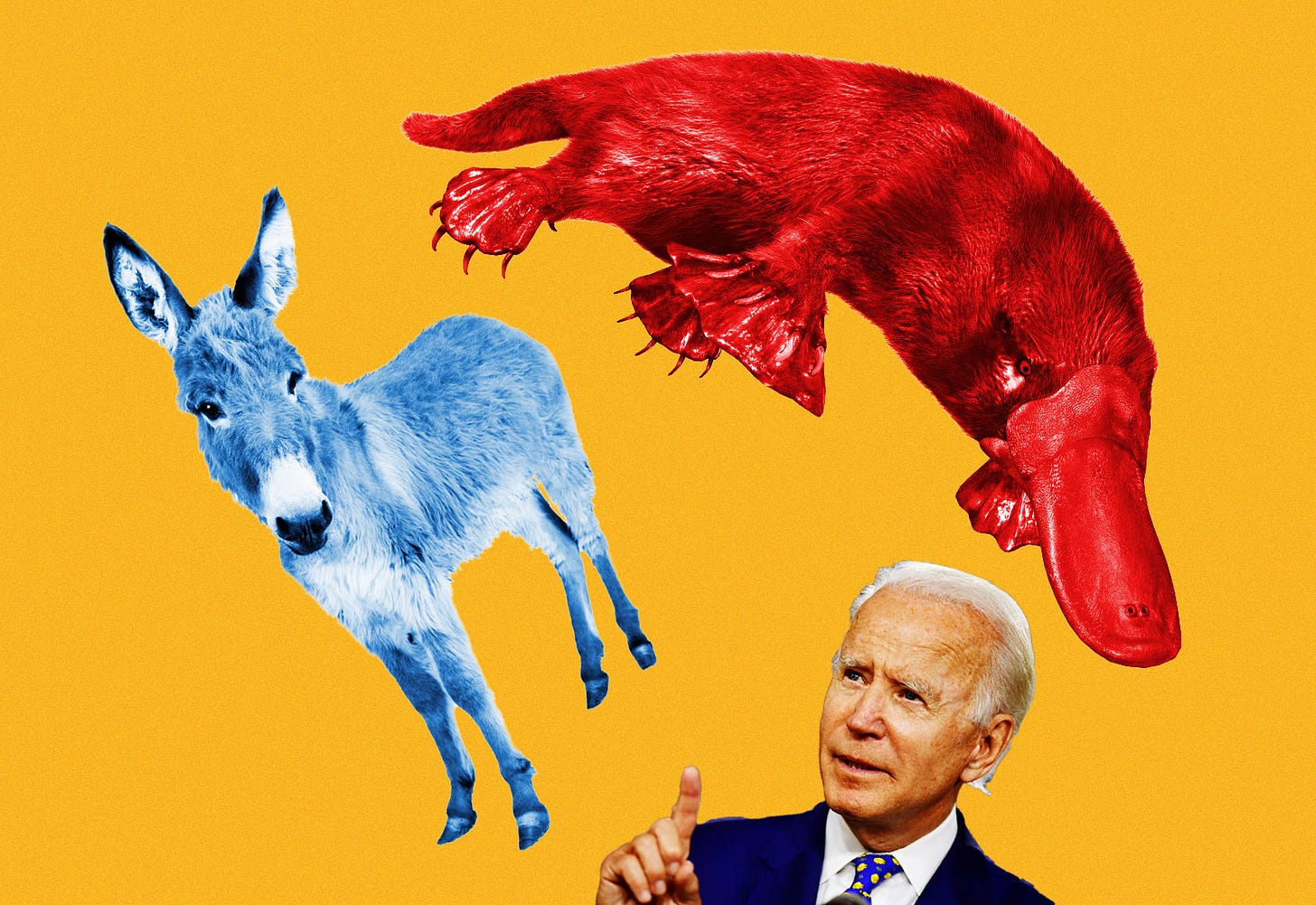Towards A Real Democratic Majority
Three theses in search of political entrepreneurship.
The headline from the new Quinnipiac poll is pretty straightforward: The Republican party remains Donald Trump’s party.
No fewer than 84 percent of Republicans have a favorable opinion of Donald Trump. Two-thirds of Republicans want him to run for president. And most of the rest of the remaining third would prefer a Republican candidate who mostly agrees with, rather than disagrees with, Donald Trump.
Meanwhile, the most prominent recent Republican critic of Donald Trump—Liz Cheney—is now deeply unpopular with Republicans: 12 percent of Republicans have a favorable view of Cheney, while 52 percent of Republicans have an unfavorable view. One expects that if Cheney’s name-ID was higher among Republican voters, then these numbers would be even more lopsided. Her -40 percent net favorability would be higher if she were better known.
On the other hand, in what is surely Quinnipiac’s most striking finding, Democrats—by 44 percent to 16 percent—have a favorable view of Cheney.
Think about that. Trump is so much at the center of our politics that a conservative Republican such as Cheney can become (at least temporarily) a favorite of Democrats simply because she has straightforwardly and steadfastly criticized Trump.
Now hold in mind the fact that Democratic voters seem well-disposed to anti-Trump Republicans. And then consider three three arguments—correct arguments, I believe—made on this website over the last few months.
1. Red Dogs
In December, Tim Miller explained that the Democrats and Republicans had traded blocs of voters in the last several years. While Trump has picked up even more white, non-college voters, a number of mostly suburban and better-educated, and often female, anti-Trump Republicans have moved over to become, in effect, a wing (or a mini-wing) of the Democratic party.
Some of these new Red Dog Democrats may wish the trade hadn’t happened. But it has. Reality being what it is, the trade isn’t being reversed. And sports teams have, after all, won championships with new players who at first yearned to be back with their old team.
So Tim Miller’s core message to anti-Trump Republicans is: You’ve been traded. Get used to it. Make the best of it.
2. The Platypus
In March, the moderate Democrat Liam Kerr elaborated on Miller’s argument: The management of the new team could and should do a little more to make the best of its new players. The core of his argument:
Both a centrist third party and a pro-democracy GOP are unicorns: It’s easy to picture what they look like, but they’re the stuff of imagination.
The viable path to saving our democracy is more like a platypus: An animal which sounds ridiculous when you describe it—a tiny seal with a duck beak, webbed feet, and a bushy tail?--but is, in fact, quite real.
The path forward . . . is a weird, unsettling platypus-like option: Having Democrats start to woo “future former Republicans.” Kerr has in mind actually recruiting “future former Republicans” to run for office as Democrats in seats and states where traditional progressive Democrats are likely to lose. These candidates don’t have to be literal former Republicans, though they could be. But they have to appeal to the, let’s say, 12 percent of Republicans who like Liz Cheney. Because if you can hold the traditional Democratic voters and pick up some of those Republicans, you can win Senate and House seats.
3. The Biden Wing
Which brings us to the third Bulwark piece I want to quote from, a May 27 article by Mona Charen. In the course of making a broader argument about the dangers a rise in crime and inflation pose to the Democratic party and the Biden administration, Charen remarks:
It’s crucial for Biden’s presidency to be successful. There are two reasons: 1) The country needs a breather, and 2) the Republican party is not fit to hold power. Perhaps it may be again sometime in the future, but for now, it’s a danger to democracy.
So, Charen argues, it’s important for the country, at least for now, that Democrats govern successfully and be able to win elections.
Put this together and you get three theses.
There is a pool of ex-Republican voters (and conceivably, office holders) available to the Democratic party.
Many current Democratic voters are open to including these future former Republicans in their coalition.
It would be good to move the relative strength of the two parties off the current knife’s edge, and for the Democrats to become the nation’s majority party as quickly and as decisively as possible.
Can these three theses be acted on?
Why not?
Couldn’t this be a moment when entrepreneurs could bring supply, demand, and the moment together in the political marketplace to create an expanded pro-democracy, governing majority party. With entrepreneurship and leadership on all fronts—in politics and policy, among the public and among elites—this doesn’t seem an impossible task.
The alternative is to remain mired in a kind of political liquidity trap where the political market will equilibrate at a place that is suboptimal for democracy.
Or, to end with Lincoln rather than Keynes:
“The dogmas of the quiet past are inadequate to the stormy present. The occasion is piled high with difficulty, and we must rise with the occasion. As our case is new, so we must think anew, and act anew. We must disenthrall ourselves, and then we shall save our country.”



